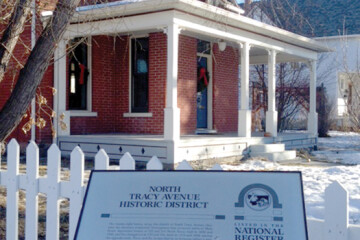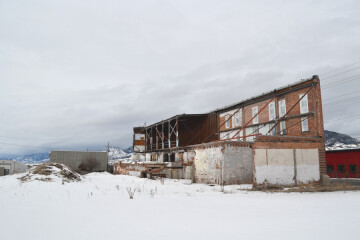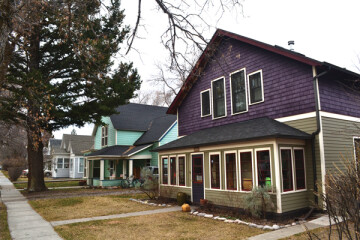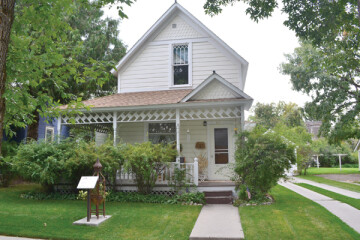Tourism's Lasting Role in Bozeman’s Economy
June is the opening month of “Tourist Season” in Bozeman, as domestic and international visitors flood through Bozeman on their way to Yellowstone National Park and the natural beauty of Southwest Montana. Tourism has shaped Bozeman’s history in a number of ways, from the establishment of a cemetery in 1872 to the City’s acquisition of the beloved Bogert Park in the late 1920’s and the development of car-culture motels and restaurants on North 7th Avenue and East Main Street in the 1960’s.
Bozeman’s proximity to what is now Yellowstone National Park (YNP) made the community a convenient outfitting base for survey and exploration expeditions. Survey work of the area began in 1869 and was completed three years later by the Hayden Geological Survey of 1871. Lead by geologist Ferdinand Hayden, the privately funded survey report included large format photographs by William Henry Jackson and paintings by Thomas Moran. As with previous expeditions, the Hayden party was escorted by officers from Fort Ellis, and Army post located three miles east of Bozeman.
The Hayden report swayed the Reconstruction-era United States Congress to create Yellowstone National Park (YNP) for the enjoyment of the nation’s citizens in 1872. Despite objections from local business interests, the act of congress prohibited settlement or natural resource extraction, like mining or timber harvests, within the park boundaries.
William and Mary Blackmore left England in 1872 to visit YNP, and thus became one of Bozeman’s first notable YNP-related tourists. Blackmore, a wealthy industrialist with an interest in anthropology and Native American culture, funded the photographs and paintings done the previous year as part of the Hayden survey. Though not British royalty, the Blackmore’s social standing within London’s high society caused locals to refer to the couple as Lord and Lady Blackmore.
The Blackmore’s halted their travel in Bozeman when Mary fell ill and died of peritontitis (an abdominal infection). In order to bury his wife, Blackmore established what is now Sunset Hills Cemetery by purchasing five acres of land on the hill standing at the east end of Main Street. Blackmore continued his visit to Yellowstone, and Ferdinand Hayden eventually named the pyramid shaped mountain in the Gallatin Mountain Range to the south of Bozeman Mount Blackmore in Mary’s honor. Mount Blackmore is now a popular hiking trail accessible through the Hyalite recreation area in the Gallatin National Forest.
The Northern Pacific Railway’s arrival in Livingston in 1882 and Bozeman in 1883 provided easier access to YNP. To spur passenger fares along its railroad line, the NP advertised YNP as “Wonderland” in promotional pamphlets finished with photographs of the area’s natural wonders. The NP Railway constructed a spur line to Cinnabar, and later Emigrant, in order to take visitors right to the gates of the park. Passengers disembarked from the railcars and toured the park in stagecoaches, by wagon and by horseback. A handful of adventurous visitors toured the park by bicycle; no easy feat considering the rudimentary bicycle technology of the late 19th century, the poor roads, and high altitude of the Park.
In 1912 the Chicago, St. Paul, Milwaukee and Pacific Railroad, called the Milwaukee Road, completed its transcontinental line through Montana. To compete with the Northern Pacific’s access to YNP, the Milwaukee Road developed a spur line south of Three Forks to Salesville, at the mouth of Gallatin Canyon. In 1927, the community was renamed Gallatin Gateway and the Milwaukee Road constructed the Gallatin Gateway Inn to offer tourists lodging on either end of their visit to the park.
The Milwaukee Road’s tracks looped east from Gallatin Gateway through the southern end of the eastern Gallatin Valley and entered Bozeman through the south side of town. An industrial area of seed pea mills and warehouses developed in proximity to the Milwaukee’s terminus in Bozeman, near East Main Street and South Wallace Avenue.
When the Milwaukee Road abandoned operations west of Miles City, Montana, in 1977, the portions of the former rail line not in the City Limits reverted to private ownership. The Milwaukee Road’s right-of-way within the City of Bozeman became the Gallagator Trail, a heavily used recreational path connecting Main Street to Bozeman’s south side. The Milwaukee Road’s rail yard and passenger depot are now the location of the Bozeman Public Library.
Automobiles began replacing train travel to YNP even before the Milwaukee Road built the Gallatin Gateway Inn. A group of North Dakota businessmen hit on an idea to bring tourists through their communities: develop good roads and advertise a destination. The Yellowstone Trail Association was formed in October 1912 to coordinate efforts at improving roads, and thus enhancing automobile tourist-related business opportunities between Minneapolis and YNP. The length of the Yellowstone Trail eventually grew from Massachusetts to Washington State, and organizers adopted the slogan of “A Good Road from Plymouth Rock to Puget Sound.”
Despite poorly maintained roads within the Park, visitors enjoyed the freedom of visiting YNP at their own pace and under their own direction. By 1915, 1,000 automobiles entered the Park each year. Many of the visitors chose to camp in the park rather than pay for hotel lodging.
Bozeman’s business community developed tourist facilities to accommodate those visiting the park by automobile. Bogert’s Grove, a popular camping location on South Church Avenue, was purchased by the City of Bozeman in the late 1920’s to provide tourists a safe and pleasant place to camp adjacent to the City’s commercial district. The City used Depression Era Public Works Administration funding to construct a swimming pool and bandstand in what is now Bogert Park in the late 1930’s.
Tourist accommodations evolved with the changing expectations of travelers. Sanborn Fire Insurance Maps reveal the presence of at least two other “tourist camps” by 1943. A predecessor to “motels,” these camps offered visitors a room to stay in, a place to park their car in front of the room, and a communal bathroom and shower facility. One, at the intersection of South 7th Avenue and West College Street, provided ten separate lodging spaces. Another, located on North Willson between West Villard and West Short Street, offered 24 rooms in modern log “cabins” finished in the rustic style commonly called “parkitecture.”
Automobile tourism grew exponentially in the post-World War II era. The advent of the Interstate Highway System brought record numbers of visitors to the National Parks. By the middle 1960’s new motels located just off of the interstate on North 7th Avenue and East Main Street provided modestly priced lodging for visitors. Located on North 7th Avenue, the Rambler Inn (now known as the Bozeman Inn) was finished in 1957 and featured two stories of motel rooms with an attached bathroom and an outdoor pool.
Heritage tourism continues to shape Bozeman’s economy. Through a partnership with the Historic Preservation Board, the Extreme History Project offers six different regularly guided walking tours of Bozeman’s historic places. Please visit http://adventurethroughtime.org/ for a tour schedule.









